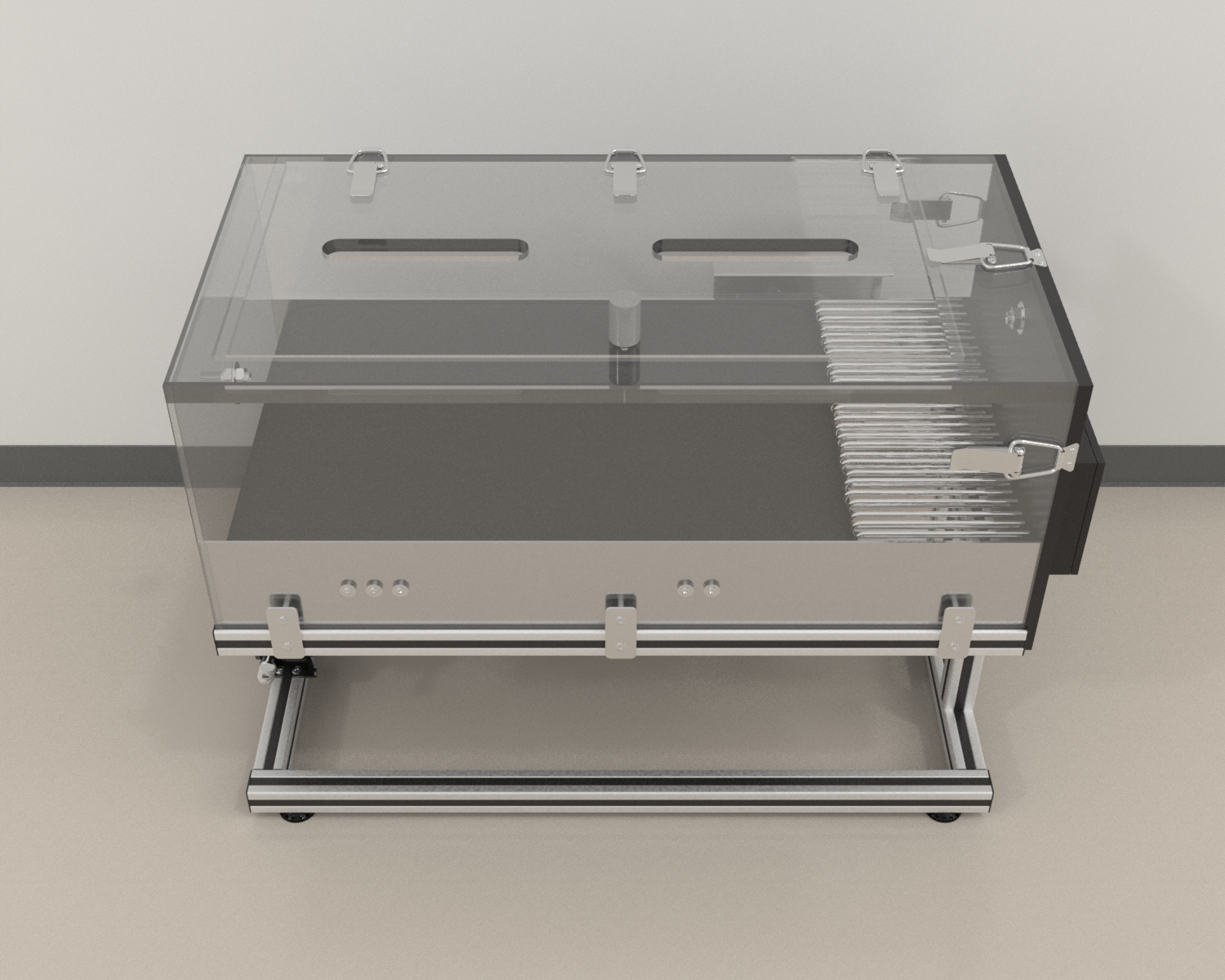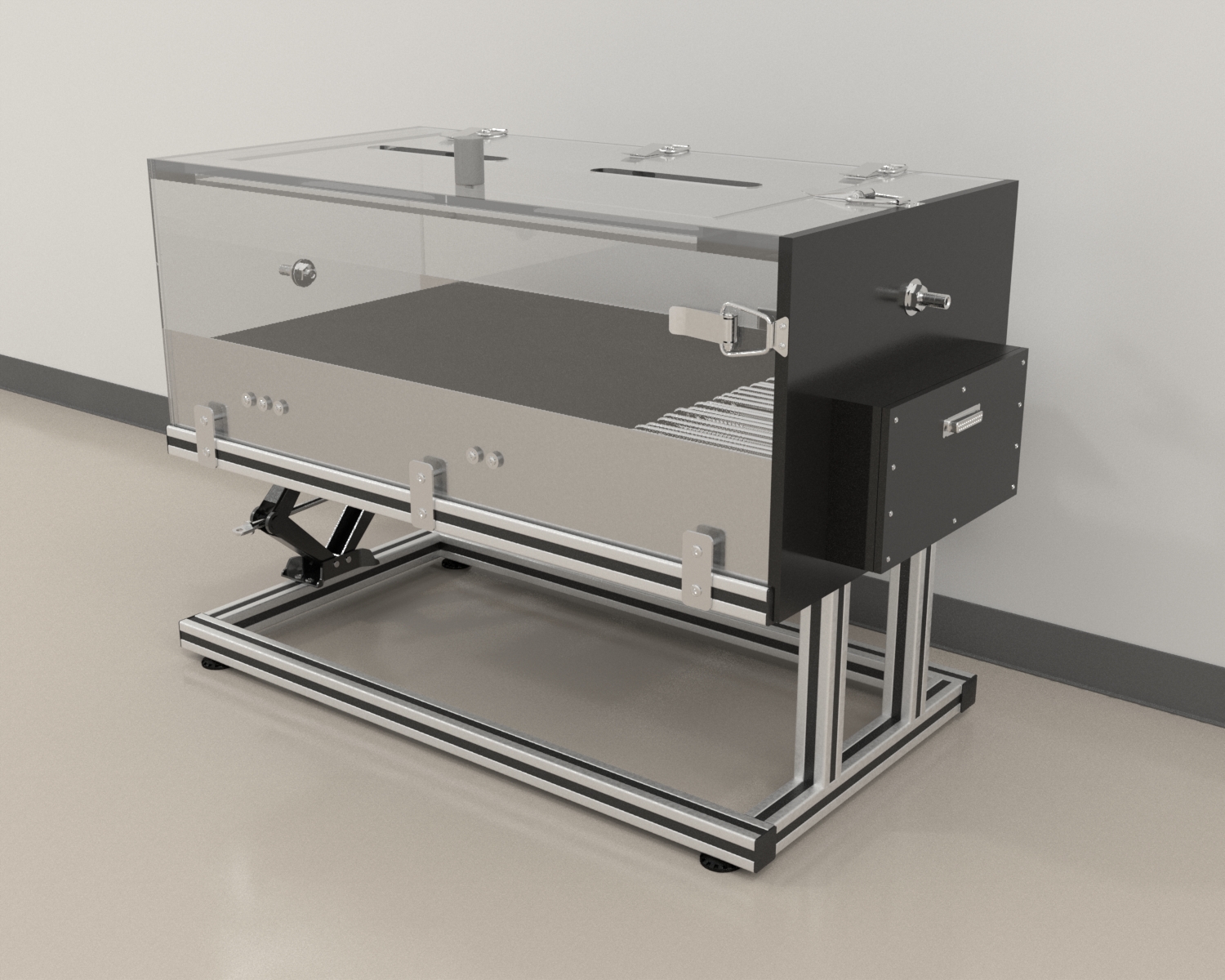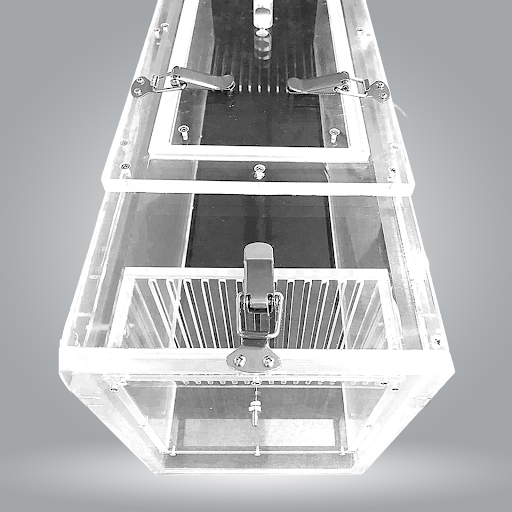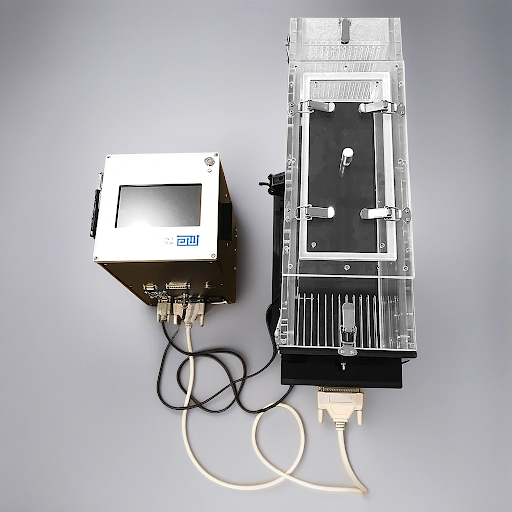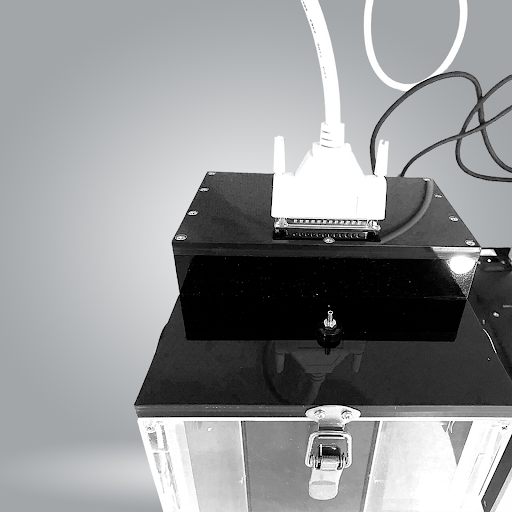Description
The treadmill is a popular exercise system used to force-train rodents. Our Rodent Metabolic Treadmill is a variation of the Classic Treadmill that comes with multiple features, including Easy sloping, easy-grip belt, low noise, comprehensive data collection, and an easy-to-protocolize treadmill for activity experiments, with a Metabolism System.
The Rodent Metabolic Treadmill device is a single-lane treadmill designed for metabolic measurement in rodents. Measurable parameters include O₂ and CO₂ consumption per unit time, respiratory entropy (RQ), respiratory exchange rate (RER), metabolic rate, and energy consumption.
Our Rodent Metabolic Treadmill device treadmill is constructed using aluminum and acrylic. The runway is made of a textured belt that facilitates animal grip. The speed of the lane can be varied between 0 to 80 meters per minute with acceleration increments of 0.1 meters/minute. The runway incline can be varied between 0 to 25 degrees. The device comes with associated software to control and configure the experiment.
Maze Engineers offers a wide range of activity and motor related-apparatuses here
Mouse
$ 5990
Per Month- Chamber dimensions: 5 × 24.5 × 6.5 cm (W × L × H)
- Independent Lane Control
- Speed: 1-100 meter /minute
- Speed step: 1 meter/ minute
- Acceleration: Adjustable acceleration in 0.1 meter/minute increments
- Slope degree ± 35°
- Adjustable current Stimulus: 0.05 – 4 mA
- Aluminium frame
- Capacitive touch screen: clear display and intuitive interface for experiment setting and display
- Real-time display
Rat
$ 6490
Per Month- Chamber dimensions: 9 × 47.5 × 12 cm (W × L × H)
- Independent Lane Control
- Speed: 1-100 meter /minute
- Speed step: 1 meter/ minute
- Acceleration: Adjustable acceleration in 0.1 meter/minute increments
- Slope degree ± 35°
- Adjustable current Stimulus: 0.05 – 4 mA
- Aluminium frame
- Capacitive touch screen: clear display and intuitive interface for experiment setting and display
- Real-time display
Documentation
Introduction
The Rodent Metabolic Treadmill is a single-lane treadmill used for the metabolic measurements of rodents. It consists of a textured running belt enclosed within a chamber constructed of acrylic and aluminum. The chamber also includes a shock grid, which serves as an aversive stimulus to motivate exercise. It is available in two sizes, smaller size for mice and a larger size for rats.
The Rodent Metabolic Treadmill utilizes a forced training model in which rodents are removed from their home cages and forced to run on the treadmill. This allows measurements of the rodents’ speed, distance, and endurance in acute and chronic stress training conditions, which can be used for metabolic and cardiovascular research. Rodents can be tasked to perform moderate or high-intensity training by adjusting the speed, duration, and inclination of the treadmill according to the experiment’s need. The treadmill’s speed can be adjusted between 0 to 80 meters per minute with acceleration increments of 0.1 meters/minute. Moreover, the incline of the runway can be set between 0 to 25 degrees.
The Rodent Metabolic Treadmill can be used as a model to assess exercise behaviors in humans, including activity level, VO2max, and exercise endurance. These parameters can be used to examine regulatory processes associated with exercise. Studies have utilized rodent treadmill running to assess cardiomyopathy, in which treadmill running improved oxidative parameters in rodents with cardiomyopathy (Kim & Hwang, 2015). Moreover, the effects of treadmill exercise were also investigated in studies to assess oxidative damage in the hippocampus, in which facilitated cognitive improvement (Cechetti et al., 2012).
Apparatus and Equipment
The Rodent Metabolic Treadmill has clear, removable acrylic maze walls and an aluminum frame. It is available in two sizes.
- Total chamber dimensions: 24.5cm L x 5cm x 6.5cm
- Belt: 20cm L x 5cm W
- Shock Grid: 4.5cm L x 5cm W
Both versions have independent lane control, adjustable speed between 1-100 meter/minute, speed step of 1 meter/minute, adjustable acceleration in 0.1 meter/minute increments, slope degree of ±35°, and adjustable current stimulus between 0.005 – 4 mA/. They also include a clear capacitative touch screen with a clear display and intuitive interface.
Up to 4 metabolic treadmills can be analyzed using our Metabolic Measurement System.
Measurement Parameters
- O₂ and CO₂ consumption per unit time, accuracy 1ml
- Resting Energy Requirement (RER)
- Energy expended
- Metabolic rate (MR)
- Calorific Value (CV):
- Temperature, accuracy 0.1℃; humidity accuracy ±1% RH; air pressure, accuracy 0.075%
- Applicable to mice and rats
Sensor Specifications
|
Parameter |
CO2 sensor |
O2 sensor |
|
Detection range (percentage) |
0-100% | 0.1-100% |
|
Measurement accuracy (percentage) |
0.007% |
0.5% |
|
Response time (seconds) |
< 0.05 |
< 4.0 |
| Resolution (percentage) | 0.007% |
0.01% |
Technical Parameters
- A small portable unit, solid case with handle, with maximum portability can be used on-site under various complex field environmental conditions.
- New control unit with integrated touchscreen GUI that simultaneously displays oxygen, carbon dioxide, water vapor pressure, atmospheric pressure, humidity in real-time.
- Pump flow 1-1000 ml per minute, adjustable
- Operating temperature 5-40°C, storage -20-60°C
- Operating humidity 0-95%
- Lithium-ion rechargeable battery pack (24v10AH) can be used in field experiments for at least 8 hours.
- Store a large data set and easy to export data with USB drive to CSV. file
- Can run experiments online or offline. The offline data can be exported to software on PC for further analysis,
- Fully integrated with Maze Engineers Metabolic Treadmill.
Training Protocol
Clean the treadmill with 70% ethanol solution, and wipe and air dry it before every session.
The following is a sample protocol to assess exercise endurance in rodents:
Allow the subject to acclimate to the treadmill by allowing it to sit on it for 3 minutes. After 3 minutes have elapsed, set the treadmill’s speed at 16 m/min. Increase the speed by 4 m/min every 3 minutes until a maximum speed of 40 m/min is reached. If the subject is still running at the maximum speed, increase the speed by 5% every 3 minutes. End the task when the subject sits on the shock grid for 5 seconds or 36 minutes, 40 m/min, and 15% grade have elapsed.
The following is a sample protocol to examine the effects of exercise on a high-fat diet using the Rodent Metabolic Treadmill:
Divide the subjects into runner and sedentary groups and feed both groups a high-fat diet.
Subject the runner group to 30 minutes of treadmill running at a speed of 5 m/min and an inclination of 10% for 30 minutes a day, five times a week for 26 weeks. Subject the sedentary group to running only during exercise exhaustion tests. Conduct exhaustion tests with the treadmill inclined 25% uphill. Place the subject on the treadmill and allow it to run for 14 m/min for 6 minutes. Increase the speed by 2 m/min every 2 min until the subject is exhausted, characterized by the inability to return to running within 10 seconds after contact with the shock grid. Conduct exhaustion tests only at weeks 0 and 25 of the study.
Strengths and Limitations
Strengths
The Rodent Metabolic Treadmill is used as a force-training model of exercise, which is used to analyze rodents’ endurance. It is equipped with a running belt that is textured, which helps facilitate the rodent’s grip while running. In addition, parameters such as speed, inclination, and running duration can be set on the treadmill according to experimental needs. The speed can be adjusted between 1-100 meters/minute with adjustable acceleration in 0.1 meter/minute increments, and the incline of the runway can be set between 0 to 25 degrees. The treadmill chamber also includes a shock grid as an aversive stimulus to motivate the rodents to run. The shock grid’s current can also be adjusted between 0.005 – 4 mA/. The Rodent Metabolic Treadmill can be used in studies that investigate the effect of exercise on various components, including oxidative stress, diet, anxiety, and sleep deprivation. The treadmill is available in two sizes, allowing experimenters to choose a model that fits the rodent they’re studying.
Limitations
In studies involving pregnant rodents, the shock grid should not be used since it may be too aversive. Instead, tail touching should be used to motivate pregnant rodents to run. The same rodent strain and age should be utilized for reproducible studies since it can affect experimental results. Moreover, differences in the running speed, inclination/declination of the treadmill, and duration of running between experiments can also affect results. Therefore, all parameters should be considered closely to create a consistent animal model using the Rodent Metabolic Treadmill.
Summary
- The Rodent Metabolic Treadmill is a single-lane treadmill used for the metabolic measurements of rodents.
- It consists of a textured running belt with a shock grid enclosed within a chamber constructed of acrylic and aluminum.
- It is available in two sizes, smaller size for mice and a larger size for rats.
- The Rodent Metabolic Treadmill utilizes a forced training model to measure rodents’ speed, distance, and endurance.
- The speed and inclination of the running belt can be set according to experimental needs, allowing the performance of moderate or high-intensity training.
- The Rodent Metabolic Treadmill can be used as a model to assess exercise behaviors in humans, including activity level, VO2max, and exercise endurance, which can be used to examine regulatory processes associated with exercise. Moreover, it can be used to assess the effect of exercise on anxiety-like behaviors, oxidative stress, and high-fat diet-induced hypothalamic inflammation.

